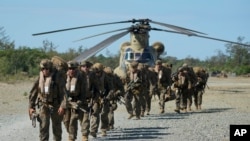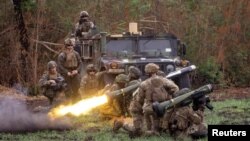Hundreds of American and Philippine troops concluded Monday a new combat exercise in the northern Philippines that tested their endurance in more than a week of brutal heat and volatile weather, and braced them to respond to any threat in tropical jungles and on scattered islands, two U.S. and Philippine generals said.
The Biden administration has been strengthening an arc of military alliances in the Indo-Pacific to better counter China, including in any possible confrontation over Taiwan and other Asian flash points. The move has dovetailed with Philippine efforts to shore up its territorial defenses amid escalating disputes with Beijing in the South China Sea.
The large-scale battle drills, which have been held in Hawaii in recent years under the U.S. Army’s Joint Pacific Multinational Readiness Center, have been introduced in the Philippines this year. There is also a version in Alaska. The exercises allow the U.S. Army, its allies and friendly forces to train in extreme conditions “where they are most likely to operate from archipelagos, jungles and heat in the tropics to high-altitude and extreme cold in the Arctic,” said Major Adan Cazarez, a public affairs officer of the U.S. Army’s 25th Infantry Division.
The June 1-10 warfighting exercise began with an air assault on mock enemy forces to allow the deployment of U.S. and Philippine soldiers who secured an area, which served as a staging ground before a major offensive. When their communication lines for supplies were threatened, top commanders decided to shift to a defensive assault and repelled the enemy attempt and successfully launched the offensive.
Key aspects of the mock battle, including the planning, deployments, logistical preparations and contingency readiness, were reviewed by military assessors for combat efficiency.
The combat exercises, Cazarez said, were integrated in annual U.S.-Philippine army joint exercises called Salaknib for the first time this year. About 1,500 U.S. and Filipino soldiers participated in the new battle drills staged in a hinterland in Fort Magsaysay, a sprawling Philippine army camp in an agricultural region known for its scorching weather. The temperature this year has been exacerbated by El Nino, an occasional warming of the Pacific that shifts global weather patterns.
"The terrain is without question some of the most difficult that our soldiers have ever had the experience to move into. The heat on a daily basis was well over 95 degrees (Fahrenheit; 35 degrees Celsius) and it challenged us from a sustainable perspective,” Major General Marcus Evans, commander of the U.S. Army’s Hawaii-based 25th Infantry Division, told The Associated Press in an online interview from the battle training site.
Coordinating artillery and aerial fire and maneuvers “on a very challenging piece of terrain and, really, unforgiving temperatures, were all things that added to the overall training value,” Evans said. He added that American pilots also had to adjust to the region’s unpredictable weather.
Philippine army Major General Andrew de Lara Costelo said the combat drills were designed to allow U.S. and Philippine forces and potentially other allies to operate seamlessly in future contingencies.
“This fosters interoperability and shared tactics, techniques and procedures,” Costelo told the AP.
“By working together, we harness our combined strengths, knowledge and capabilities, ensuring that we are prepared to face any challenges that may arise,” he said.
The war exercises were staged after the conclusion of two larger back-to-back exercises earlier this year between U.S. and Philippine forces, the Salaknib and the Balikatan — Tagalog for shoulder-to-shoulder — which involved more than 16,000 U.S. and Philippine military personnel in their largest combat maneuvers that involved live-fire drills in and near the disputed South China Sea. Several countries sent military observers.
China has vehemently opposed the combat exercises and increased deployments of American forces to Asia, including in the Philippines, saying such military presence was endangering regional stability and was designed to contain Beijing. The Philippine military says the military drills didn't target any country and served to deter aggression.
Last year, Philippine President Ferdinand Marcos Jr. defended his decision to allow a U.S. military presence in more Philippine military camps under a 2014 defense pact, saying it was vital to his country’s territorial defense.
China had warned that the increased U.S. military presence would “drag the Philippines into the abyss of geopolitical strife.”










